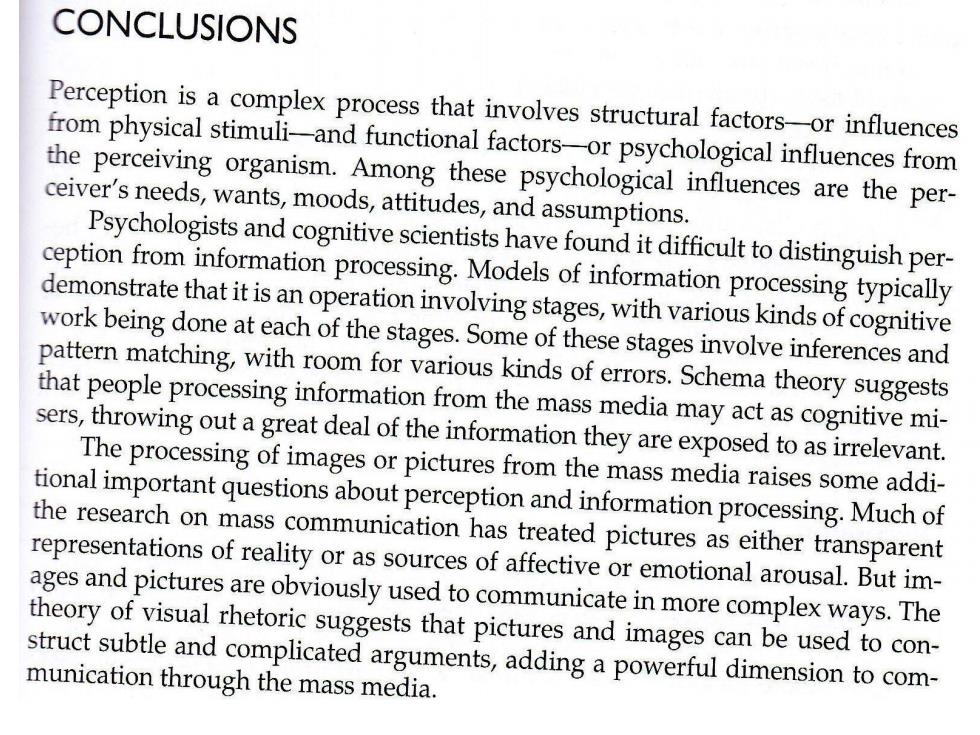
CONCLUSIONS Perception is a complex process that involves structural factors-or influences from physical stimuli-and functional factors-or psychological influences from the perceiving organism.Among these psychological influences are the per- ceiver's needs,wants,moods,attitudes,and assumptions. Psychologists and cognitive scientists have found it difficult to distinguish per- ception from information processing.Models of information processing typically demonstrate that it is an operation involving stages,with various kinds of cognitive work being done at each of the stages.Some of these stages involve inferences and pattern matching,with room for various kinds of errors.Schema theory suggests that people processing information from the mass media may act as cognitive mi- sers,throwing out a great deal of the information they are exposed to as irrelevant. The processing of images or pictures from the mass media raises some addi- tional important questions about perception and information processing.Much of the research on mass communication has treated pictures as either transparent representations of reality or as sources of affective or emotional arousal.But im- ages and pictures are obviously used to communicate in more complex ways.The theory of visual rhetoric suggests that pictures and images can be used to con- struct subtle and complicated arguments,adding a powerful dimension to com- munication through the mass media
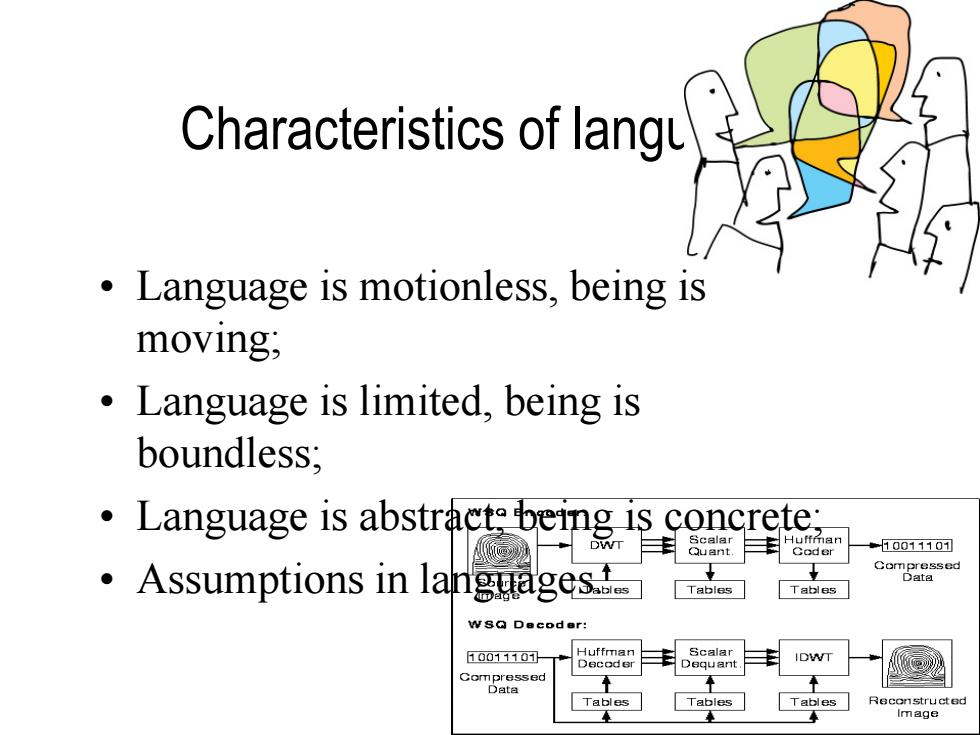
Characteristics of lang Language is motionless,being is moving; Language is limited,being is boundless; Language is abstracts being is s concrete: DWT 马月月f Huffman Quant. Coder 10011101 Assumptions in languages. Tables Tables WSQ Decoder: 10011101 Huffman Scalar DWT equant Data able
Characteristics of languages • Language is motionless, being is moving; • Language is limited, being is boundless; • Language is abstract, being is concrete; • Assumptions in languages
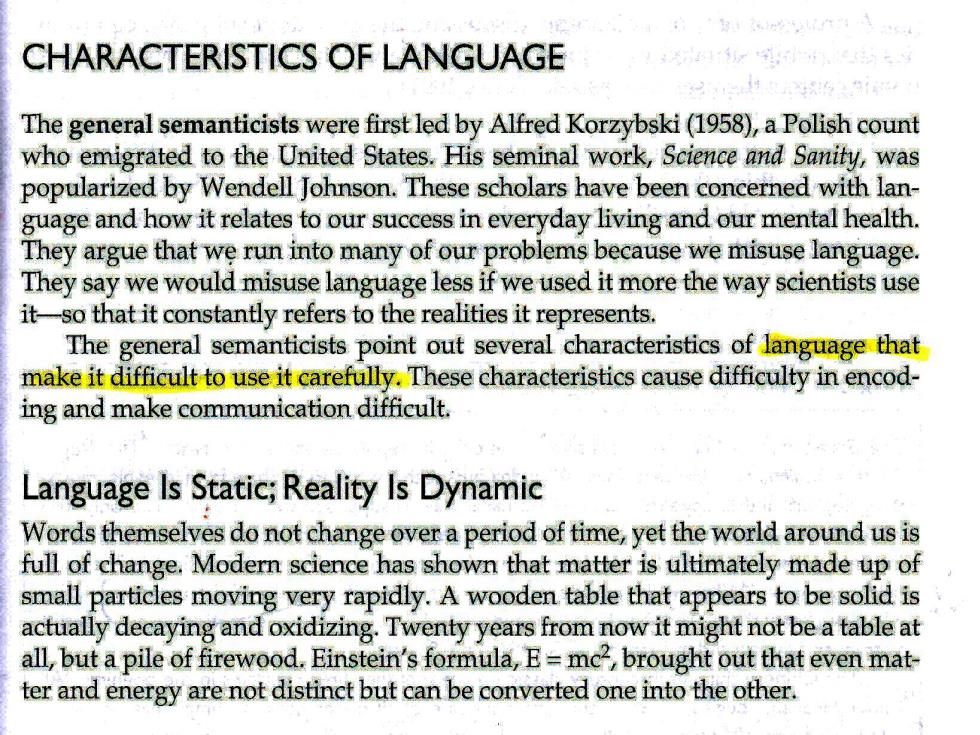
CHARACTERISTICS OF LANGUAGE The general semanticists were first led by Alfred Korzybski(1958),a Polish count who emigrated to the United States.His seminal work,Science and Sanity,was popularized by Wendell Johnson.These scholars have been concerned with lan- guage and how it relates to our success in everyday living and our mental health. They argue that we run into many of our problems because we misuse language. They say we would misuse language less if we used it more the way scientists use it-so that it constantly refers to the realities it represents. The general semanticists point out several characteristics of language that make it difficult to use it carefully.These characteristics cause difficulty in encod- ing and make communication difficult. Language Is Static;Reality Is Dynamic Words themselves do not change over a period of time,yet the world around us is full of change.Modern science has shown that matter is ultimately made up of small particles moving very rapidly.A wooden table that appears to be solid is actually decaying and oxidizing.Twenty years from now it might not be a table at all,but a pile of firewood.Einstein's formula,E=me2,brought out that even mat- ter and energy are not distinct but can be converted one into the other
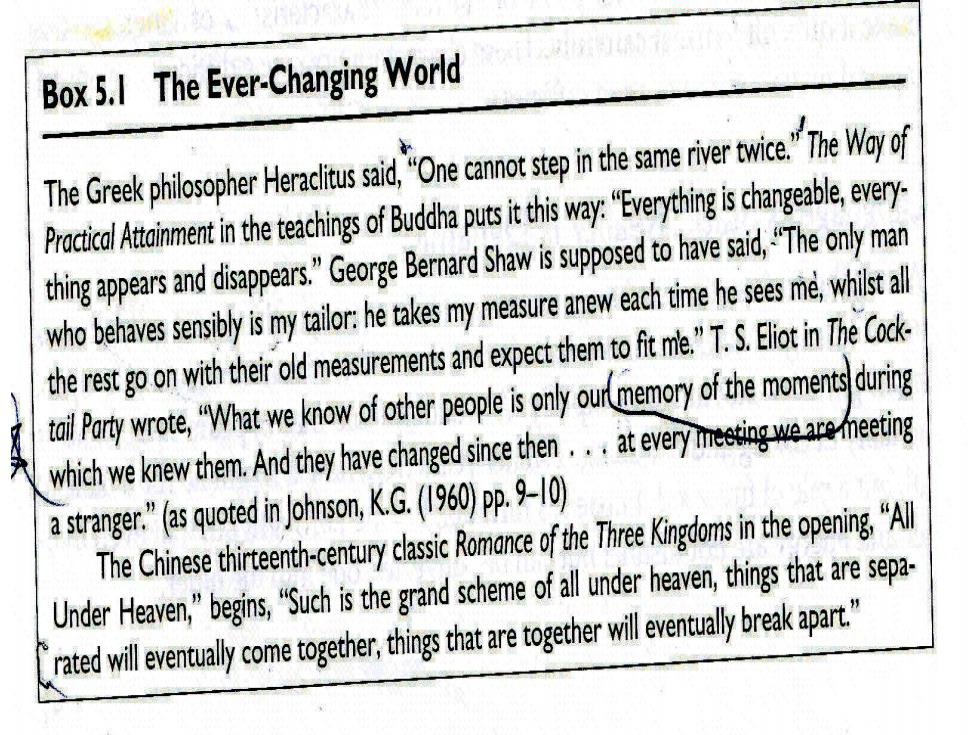
Box 5.1 The Ever-Changing World The Greek philosopher Heracitus sideo step in the same river twice.The Way of PriAtt the teacngsof Buddha ptsithis way:Everything is changeable,very thingappears and disappears.r Bernard Shaw is supposed to have sid,Theony man who behaves sensibly is my talr he takes my measure anew ach time he see me,whilstall the restgwith theirdmeasurements and expect themme.S.i The Cock- tPartyroteWhatwe know ofother people isnly ou memory of the momentsrin which we knew them.And they have changed since thenat everyn astranger.(as quoted in Johnson,K.G.(1)pp.10) The Chinese thirteenthryassi Romance ofthe Three Kingdoms in thepeningAll Under Heaven,begns,Su is the grand scheme ofall under heaven,things that are sepa- rated will eventuallymeoetherhings that areoeher wll eventlly break apart
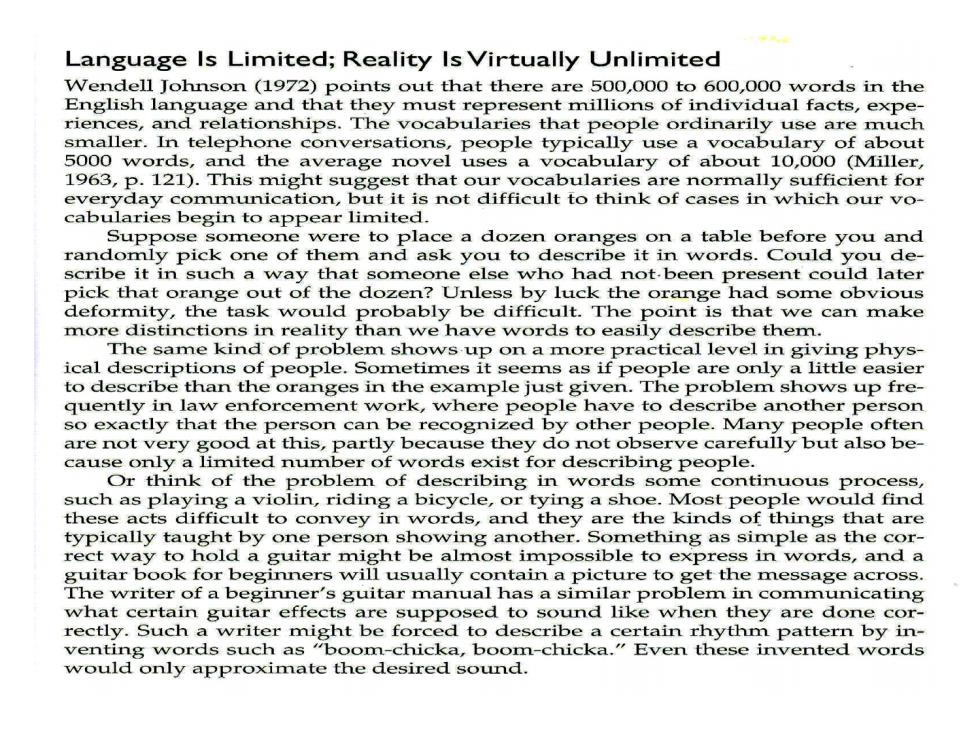
Language Is Limited;Reality Is Virtually Unlimited Wendell Johnson(1972)points out that there are 500,000 to 600,000 words in the English language and that they must represent millions of individual facts,expe- riences, and relationships.The vocabularies that people ordinarily use are much smaller.In telephone conversations,people typically use a vocabulary of about 5000 words,and the average novel uses a vocabulary of about 10,000(Miller, 1963,p.121).This might suggest that our vocabularies are normally sufficient for everyday communication,but it is not difficult to think of cases in which our vo- cabularies begin to appear limited. Suppose someone were to place a dozen oranges on a table before you and randomly pick one of them and ask you to describe it in words.Could you de- scribe it in such a way that someone else who had not been present could later pick that orange out of the dozen?Unless by luck the orange had some obvious deformity,the task would probably be difficult.The point is that we can make more distinctions in reality than we have words to easily describe them. The same kind of problem shows up on a more practical level in giving phys- ical descriptions of people.Sometimes it seems as if people are only a little easier to describe than the oranges in the example just given.The problem shows up fre- quently in law enforcement work,where people have to describe another person so exactly that the person can be recognized by other people.Many people often are not very good at this,partly because they do not observe carefully but also be- cause only a limited number of words exist for describing people. Or think of the problem of describing in words some continuous process, such as playing a violin,riding a bicycle,or tying a shoe.Most people would find these acts difficult to convey in words,and they are the kinds of things that are typically taught by one person showing another.Something as simple as the cor- rect way to hold a guitar might be almost impossible to express in words,and a guitar book for beginners will usually contain a picture to get the message across. The writer of a beginner's guitar manual has a similar problem in communicating what certain guitar effects are supposed to sound like when they are done cor- rectly.Such a writer might be forced to describe a certain rhythm pattern by in- venting words such as "boom-chicka,boom-chicka."Even these invented words would only approximate the desired sound